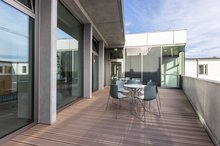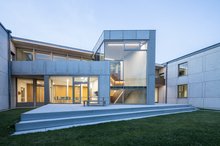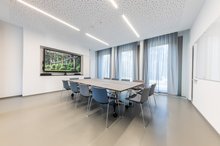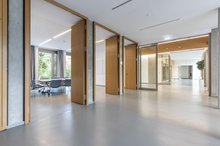History
In the following we provide a brief overview of some historical facts about the WMI, its scientific directors, important discoveries made at WMI, as well as the key research directions over the past decades.
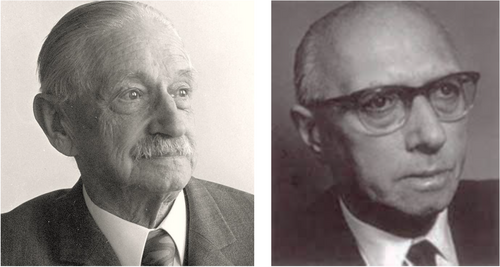
A Brief History of WMI
The Founders
The scientific roots of WMI go back to Walther Meißner (1882-1974). He was appointed to the Chair of Technical Physics at the TH Munich (now Technical University of Munich) in 1934. During 2nd World War, his low temperature laboratory was evacuated to to Hersching into two barracks close to the shore fo the beautiful Lake Ammer. As a politically clean person he became President of the Bavarian Academy of Sciences and Humanities (BAdW) in 1946. Together with Claus Paul Alfred Clusius (1903-1963) he proposed the foundation of the Commission for Low Temperature Physics of the BAdW and the adoption of the Herrsching barracks by the commission.
The WMI Building
The first research activities were started in the Herrsching barracks already in 1946 . After the retirement of Walther Meißner in 1952, Heinz Maier-Leibnitz, who also followed Walther Meißner on the Chair for Technical Physics of the Technical University of Munich (TUM), became the new head of the Commission for Low Temperature Research of BAdW. The Herrsching barracks soon became too small for the rapidly growing reserach efforts. Therefore, the construction of a new building was mandatory. In 1967, the commission moved to the Garching research campus after the construction of the new "Zentralinstitut für Tieftemperaturforschung (ZTTF)" was completed (director: Prof. Heinz Maier-Leibnitz, technical director: Prof. Franz Xaver Eder). Until 1972, the theory group of the Institute Laue Langevin was hosted at the ZTTF with prominent members such as Peter Fulde. In 1980, Prof. Dr. Klaus Andres became the new director of the ZTTF again associated with the Chair for Technical Physics (E23) at TUM, followed by Prof. Dr. Rudolf Gross in 2000. In 1982, the ZTTF was renamed into Walther-Meißner-Institute for Low Temperature Research (WMI) on the occasion of the 100. anniversary of Walther Meißner's birth.
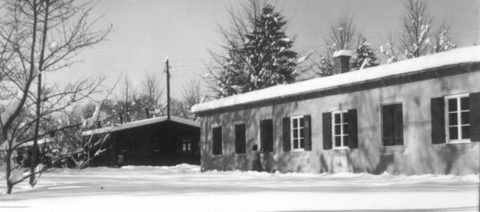

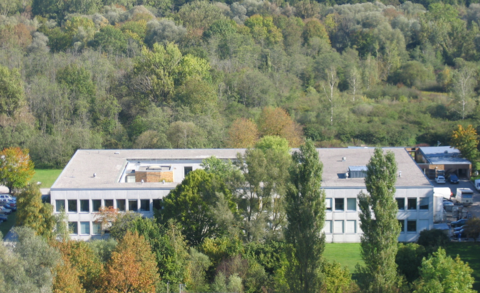
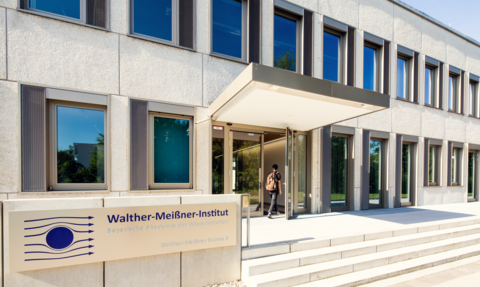
Extension and Reorientation of the WMI Research Program
Starting from 2000, the research program of WMI was considerably extended and reoriented by the new director Rudolf Gross. In particular, the new research directions (i) magnetism and spin electronics and (ii) solid-state based quantum systems and quantum technology were started from scratch. In addition, a considerable effort was started regarding materials science and nanotechnology. The start of these activities was made possible by making available the so far unused basement of the WMI building for technical infrastructure (airconditioning, particulate airfilters, pure water system etc. for cleanroom) and additional laboratory space.
The new research and technology oriented activities included the setup of a cleanroom with a 100 kV electron beam lithography system, a laser beam writer and an ICP-RIE system, thin film laboratories with several UHV sputtering tools, a UHV laser MBE system for complex oxide heterostructures and a UHV electron beam deposition system for qubit fabrication, as well as a crystal growth lab. Moreover, the experimental techniques of WMI have been extended by ultra-sensitive microwave techniques, SQUID magnetometry, FMR and spin-wave spectroscopy, and Brillouin light scattering.
Fortunately, in 2008 WMI succeeded in getting extra money from the state government within the so-called "Konjunkturpaket". This money has been used to establish the new "WMI Quantum Science Laboratory" in the basement of the building, providing about 150 m2 additional laboratory space particularly suited for low temperature facilities and ultra-sensitive studies on solid state quantum systems. The WMI Quantum Science Laboratory was fully operational early in 2011 and meanwhile hosts three new mK systems and sophisticated experimental techniques for the study of solid-state based quantum systems and circuits.
In 2016, the Bavarian Ministry for Science and Arts granted about 7 Mio. Euro for redevelopment measures of the WMI building regarding the technical infrastructure, safety requirements and energy efficiency. An important part of the building project implemented in 2017/18 was the reconstruction of the new entrance area and the main staircase, providing now direct access to the new WMI Quantum Laboratories in the basement of the WMI building as well as additional communication areas and meeting rooms in the ground floor. Moreover, it included the replacement of all windows and doors, the upgrade of the technical infrastructure for cooling water, air conditioning, liquid nitrogen and helium storage, as well as the complete redevelopment of the mechanical workshop and various safety measures.
Change in Governance Structure
With the availability of additional laboratory space and the success of the WMI in Germany's Excellence Initiative (2006-2018), Excellence Strategy (starting from 2019), and other third-party funded research projects, the research activities, the number of staff and obviously the related administrative tasks at WMI were strongly growing. Therefore, Rudolf Gross proposed in 2017 to start the appointment procedure for an additional scientific director with focus on superconducting quantum computing. Moreover, due to the strong increase of staff, research projects and administrative tasks he proposed to change the governance structure of WMI from a single director to a board of up to three scientific directors, supported by a management board headed by a managing director. This change of governance structure has been supported by the Scientific Advisory Board of WMI and the decision-making bodies of BAdW. Meanwhile, it is implemented in the new rules of order of WMI valid since October 18, 2019. With Prof. Dr. Stefan Filipp from IBM Research at Rüschlikon, Switzerland, a new scientific director with focus on quantum computing has been appointed in June 2020. Moreover, in January 2023 Prof. Dr. Peter Rabl, who previously has been affiliated with the Technical University of Vienna, Austria, joined WMI as a new scientific director with focus on applied quantum theory.
As already mentioned, it is a long tradition that WMI hosts the Chair for Technical Physics (E 23) of TUM with the scientific director of WMI being full professor at the Faculty of Physics of TUM. Following this tradition, both Stefan Filipp and Peter Rabl have been appointed full professor at TUM. In general, WMI has established tight links to research groups of both Munich universities, joining technological and human resources in the fields of experimental and theoretical solid-state and condensed matter physics, low temperature techniques, materials science as well as thin film and nanotechnology. Noteworthy, the WMI supplies liquid helium to more than 25 research groups at both Munich universities and provides the technological basis for low temperature research.
The Scientific Directors of WMI
- Prof. Dr. Walther Meißner (1946 - 1952)
- Prof. Dr. Heinz Maier-Leibnitz (1952 - 1980)
- Prof. Dr. Klaus Andres (1980 - 2000)
- Prof. Dr. Rudolf Gross (2000 - 2025)
- Prof. Dr. Stefan Filipp (since 2020)
- Prof. Dr. Peter Rabl (since 2023)
Important Discoveries
The WMI looks back on a long history of successful research in low temperature physics. In the following we list some important discoveries as well as experimental and technical developments made at WMI.
1961: Discovery of Flux Quantization in Multiply Connected Superconductors
R. Doll, M. Näbauer,
Experimental Proof of Magnetic Flux Quantization in a Superconducting Ring, Phys. Rev. Lett. 7, 51-52 (1961).
1986: Discovery of an Anomalous Temperature Dependence of the Penetration Depth in UBe13
F. Gross, B.S. Chandrasekhar, D. Einzel, K. Andres, P.J. Hirschfeld, H.R. Ott, J. Beuers, Z. Fisk, J.L. Smith,
Anomalous Temperature Dependence of the Magnetic Field Penetration Depth in Superconducting UBe13, Z. Physik B - Condensed Matter 64, 175-188 (1986).
1992: Discovery the Intrinsic Josephson Effect
R. Kleiner, F. Steinmeyer, G. Kunkel, and P. Müller,
Intrinsic Josephson Effects in Bi2Sr2CaCu2O8 Single Crystals, Phys. Rev. Lett. 68, 2394-2397 (1992).
2002: Development of Dilution Refrigerators with Pulse Tube Refrigerator Precooling - the Birth of Dry Dilution Fridges
K. Uhlig,
3He/4He Dilution Refrigerator with Pulse Tube Precooling, Cryogenics 42, 73-77 (2002).
2010: First Demonstration of Ultrastrong Light-Matter Interaction in Circuit QED
T. Niemczyk, F. Deppe, H. Huebl, E. P. Menzel, F. Hocke, M. J. Schwarz, J. J. Garcia-Ripoll, D. Zueco, T. Hümmer, E. Solano, A. Marx, R. Gross,
Circuit Quantum Electrodynamics in the Ultrastrong-Coupling Regime, Nature Physics 6, 772-776 (2010).
2010: Development of Dual Path Method for State Tomography of Propagating Quantum Microwaves
E.P. Menzel, M. Mariantoni, F. Deppe, M.A. Araque Caballero, A. Baust, T. Niemczyk, E. Hoffmann, A. Marx, E. Solano, R. Gross,
Dual-Path State Reconstruction Scheme for Propagating Quantum Microwaves and Detector Noise Tomography, Phys. Rev. Lett. 105, 100401 (2010).
2012: First Realization of Path Entanglement of Propagating Quantum Microwaves
E. P. Menzel, R. Di Candia, F. Deppe, P. Eder, L. Zhong, M. Ihmig, M. Haeberlein, A. Baust, E. Hoffmann, D. Ballester, K. Inomata, T. Yamamoto, Y. Nakamura, E. Solano, A. Marx, R. Gross,
Path Entanglement of Continuous-Variable Quantum Microwaves, Phys. Rev. Lett. 109, 250502 (2012).
2013: Discovery of the Spin Hall Magnetoresistance
This discovery was made jointly with partners at Tohoku University and TU Delft.
H. Nakayama, M. Althammer, Y.-T. Chen, K. Uchida, Y. Kajiwara, D. Kikuchi, T. Ohtani, S. Geprägs, M. Opel, S. Takahashi, R. Gross, G. E. W. Bauer, S. T. B. Goennenwein, E. Saitoh,
Spin Hall Magnetoresistance Induced by a Non-Equilibrium Proximity Effect, Phys. Rev. Lett. 110, 206601 (2013).
2013: First Demonstration of Strong Magnon-Photon Coupling
H. Huebl, Ch. Zollitsch, J. Lotze, F. Hocke, M. Greifenstein, A. Marx, R. Gross, S.T.B. Goennenwein,
High Cooperativity in Coupled Microwave Resonator Ferrimagnetic Insulator Hybrids, Phys. Rev. Lett. 111, 127003 (2013).
2017: First Experimental Observation of the Spin Nernst Effect
S. Meyer, Yan-Ting Chen, S. Wimmer, M. Althammer, S. Geprägs, H. Huebl, D. Ködderitzsch, H. Ebert, G.E.W. Bauer, R. Gross, S.T.B. Goennenwein,
Observation of the spin Nernst effect, Nature Materials 16, 977-981 (2017).
2019: First Demonstration of Remote State Preparation in the Microwave Regime
S. Pogorzalek, K. G. Fedorov, M. Xu, A. Parra-Rodriguez, M. Sanz, M. Fischer, E. Xie, K. Inomata, Y. Nakamura, E. Solano, A. Marx, F. Deppe, R. Gross,
Secure Quantum Remote State Preparation of Squeezed Microwave States, Nature Communications 10, 2604 (2019).
2020: Discovery of a New Method for Controlling Spin Currents Carried by Magnons in Antiferromagnetic Insulators
Tobias Wimmer, Akashdeep Kamra, Janine Gückelhorn, Matthias Opel, Stephan Geprägs, Rudolf Gross, Hans Huebl, Matthias Althammer,
Observation of Antiferromagnetic Magnon Pseudospin Dynamics and the Hanle Effect, Physical Review Letters 125, 247204 (2020).
2021: First experimental implementation of teleportation protocol by propagating quantum microwaves
K. G. Fedorov, M. Renger, S. Pogorzalek, R. Di Candia, Q. Chen, Y. Nojiri, K. Inomata, Y. Nakamura, M. Partanen, A. Marx, R. Gross, F. Deppe,
Experimental quantum teleportation of propagating microwaves, Science Advances 7, eabk0891 (2021)
2023: Observation of the Nonreciprocal Magnon Hanle Effect
Janine Gückelhorn, Sebastián de-la-Peña, Matthias Grammer, Monika Scheufele, Matthias Opel, Stephan Geprägs, Juan Carlos Cuevas, Rudolf Gross, Hans Huebl, Akashdeep Kamra, Matthias Althammer,
Observation of Nonreciprocal Magnon Hanle Effect, Physical Review Letters 130, 216703 (2023).
Key Research Directions
1946 - 1970 (Walther Meißner)
- foundations of superconductivity (fluxoid quantization, critical currents, type-II behavior)
- development of improved helium liquefaction systems
1970 - 1980 (Heinz Maier-Leinitz with Doll, Eder, Wiedemann)
- magnetism in rare-earth compounds (Kondo and crystal field effects)
- hyperfine interaction enhanced nuclear demagnetization
- first experiments on superfluid 3He in Germany
1980 - 2000 (Klaus Andres)
- physics of layered superconductors, intercalates
- organic and heavy fermion superconductors,
- solid 3He,
- calorimetric particle detection,
- metal-insulator transition,
- Raman spectroscopy of metals and superconductors,
- development of ultralow temperature techniques,
- theory of quantum fluids and superconductors, transport theory.
2000 - 2025 (Rudolf Gross)
- Basic Research:
- quantum phenomena and quantum coherence in solid state systems, quantum microwaves
- superconductivity and superfluidity, cuprates, pnictides and organic superconductors,
- Raman spectroscopy
- magnetism & spintroncs, including spin transport, spin dynamics, spin mechanics and spin caloritronics,
- circuit quantum electrodynamics and circuit electro-nanomechanics,
- ordering and emergent phenomena in correlated quantum matter,
- general properties of metallic systems at low and very low temperatures.
- Applied Research:
- solid-state quantum information processing
- hybrid quantum systems
- quantum microwave communication and sensing,
- superconducting and spin-based devices,
- multi-functional and multiferroic materials,
- development of low and ultra-low temperature systems and techniques.
- Materials Science, Thin Film and Nanotechnology:
- synthesis of superconducting and magnetic materials,
- single crystal growth of oxide materials,
- thin film technology of complex superconducting and magnetic heterostructures, including multi-functional and multi-ferroic material systems,
- operation of clean room with optical and electron beam lithography,
- fabrication of superconducting qubits and quantum circuits as well as superconducting, magnetic and hybrid nanostructures.
since 2020 (Stefan Filipp)
- Superconducting Quantum Computing:
- Multi-qubit operations
- Quantum Optimal Control
- Quantum Neural Networks
since 2023 (Peter Rabl)
- Applied Quantum Theory:
- quantum communication and quantum computation protocols
- theory of superconducting qubits and hybrid quantum systems
- quantum many-body effects in strongly- and ultrastrongly-coupled light-matter system
A comprehensive overview on the present research activities at the WMI can be found on the Research Page.

